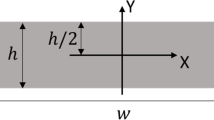Abstract
An analogy is drawn for crack propagation in brittle solids under constant deformation (strain) and under thermal shock. Following the original approach by Berry it is shown theoretically that under constant deformation an initially short crack, unstable at a critical strain, propagates to a new length which requires a finite increase in strain before it will become unstable again. Similar behavior is expected under conditions of thermal shock where an initially short crack, unstable at a critical temperature difference, propagates to a new length such that a finite increase in temperature difference is required before the crack will again continue to propagate. Relative changes in strength as a result of this type of crack behavior are predicted and verified by experimental results for two industrial polycrystalline aluminum oxides subjected to thermal shock by means of a water quench.
Résumé
On établit une analogie entre la propagation des fissures dans les solides fragiles sous déformation constante, et la propagation sous l'effet de chocs thermiques.
Selon la méthode proposée originellement par Berry, on montre par voie théorique que, sons déformation constante, une fissure de longueur initiale faible, et qui devient instable à une certaine déformation critique, se propage jusqu'à atteindre une nouvelle longueur requérant une accroissement fmi de la déformation pour devenir instable àa nouveau.
Un comportement similaire pent être attendu dans le cas de chocs thermiques. Ainsi, une fissure de faible longueur initiale, et qui devient instable sous un gradient thermique determine, atteint en se propageant une longueur nouvelle telle qu'il faut un accroissement fini du gradient de température pour que reprenne la propagation.
11 est possible de prédire les modifications relatives de résistance qui résultent de ce type de comportement des fissures. Ces prédictions ont été vérifiées par voie expérimentale en soumettant à chocs thermiques par trempe à l'eau deux types industriels d'oxydes d'aluminium polycristallins.
Similar content being viewed by others
References
J. P. Berry, J. Mech. Phys. Solids, 8 (1960) 207–216.
A. A. Griffith, Phil. Trans. Roy. Soc., A221 (1921) 163.
A. A. Griffith, Proc. Int. Cong. Appl. Mech., Delft, 55 (1924).
B. A. Boley and J. H. Wiener, Theory of Thermal Stress, John Wiley (1960).
H. S. Carslaw and J. C. Jaeger, Conduction of Heat in Solids, 2nd ed., Clarendon Press (1959).
E. Glenny and M. G. Royston, Trans. Brit. Ceram. Soc., 57 (1958) 645–77.
R. W. Davidge and G. Tappin, Trans. Brit. Ceram. Soc., 66 (1967) 405–22.
P. J. Schneider, Temperature Response Charts, John Wiley (1963).
J. R. Hague et al., Refractory Ceramics for Aerospace, The American Ceramic Society, Columbus, Ohio (1964)
P. L. Gutshall and G. E. Gross, Eng. Fracture Mechanics, 1 (1969) 463–71.
G. C. Sih, J. Appl. Mech., 29 (1962) 587–89.
J. N. Goodier and A. L. Florence, Proc. XIth Int. Congr. of Appl. Mech., (1964) 562–68.
D. P. H. Hasselman, J. Am. Ceram. Soc., 46 (1963) 535–40.
D. P. H. Hasselman, J. Am. Ceram. Soc., 52 (1969) 288–89.
F. C. Roesler, Proc. Phys. Soc., 69 (442B) (1956) 981–92.
S. J. Bennett, G. P. Anderson and M. L. Williams, J. Appl. Pol. Sc., 13 (1970) 735–43.
Author information
Authors and Affiliations
Rights and permissions
About this article
Cite this article
Hasselman, D.P.H. Crack propagation under constant deformation and thermal stress fracture. Int J Fract 7, 157–161 (1971). https://doi.org/10.1007/BF00183803
Issue Date:
DOI: https://doi.org/10.1007/BF00183803




